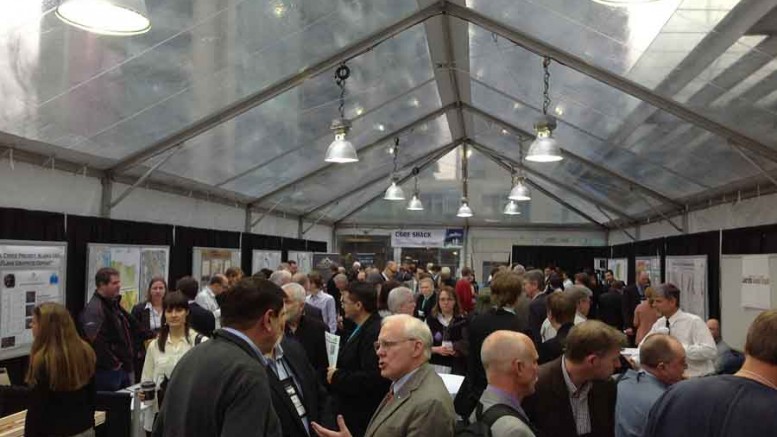The Association for Mineral Exploration British Columbia (AME BC) kicked off its Mineral Exploration Roundup 2013 on Jan. 27 with a flurry of activity here in Vancouver. Billed as the world’s premier technical mineral exploration conference, Roundup started up in style with the 9th Annual Welcome Dinner hosted by AME BC chair Michael McPhie.
During a brief address, McPhie underlined the importance of ongoing educational initiatives and community relations work geared towards helping the general public in understand the importance and breadth of the natural resource sector in British Columbia. Another theme of AME BC’s recent work has been a continued focus on public geosciences, and the securing of funding and government support for related programs.
Geoscience BC has a large presence at the conference and will release four updated provincial reports including a summary of its activities during 2012. Roundup’s technical sessions took a specific look at public geoscience initiatives.
The first afternoon keynote speaker was Hunter Dickinson (HDI) CEO Ronald Thiessen, who delved into HDI’s renewed interest in B.C. as a mining destination. He noted how HDI had moved farther afield during the 1990s, but always kept an eye on what he called the company’s “home jurisdiction.”
Thiessen compared capital and operational expenditure requirements for large mines in Latin America and South Africa, explaining how capital expenditures in emerging jurisdictions can run as high as $40,000 to $60,000 per tonne of daily throughput out of development. Whereas in B.C. Thiessen explained that Taseko Mines’ (TKO-T, TGB-X) recently-commissioned brownfield expansion at its Gibraltar copper-gold mine clocked in at just $10,000 per tonne of daily throughput.
“I think in B.C. we can develop our greenfield assets for roughly $20,000 to $35,000 per tonne of daily throughput. In operational terms we’re seeing numbers in some more challenging jurisdictions exceeding $20 per tonne to concentrate, in B.C. our large-scale operations are half that number or less,” he added.
From there Thiessen touched on a number of other credentials that underline B.C. as a desirable destination for the resource industry.
“Representatives from many regions met with us to entice us to spend our resource dollars within their borders, places across Latin America like Chile and Brazil, as well as Indonesia and many countries in Africa and Asia. I can say after these many years abroad that the opportunities have returned to North America, to the west in particular, and most importantly for us to B.C. I believe we are on the cusp of a mining renaissance in Western North America.”
Thiessen offered his perspective on the socio-political risk of resource nationalism, which he described as a “pox on the resource development industry.” He said that aside from the obvious economic penalty, if you have a non-contributing partner, “how can that partner give proper regulatory authority in terms of environmental issues and permitting? Even worse is a recent trend of resource nationalism during post-development, which happens prior to company having actually achieved return on capital.”
Regarding environmental permitting, Thiessen said “some people think permitting in North America is too challenging, and I tell them that rigorous and arduous permitting is something we need to embrace. The challenges we generally face in this regard will eventually help to instill a sense of confidence in the regulatory process, which has been lacking for some time due to the legacy of mining issues. I believe a weak regulatory regime where one of the partners, usually government, is the permitting or regulatory authority is a recipe for disaster — resulting in either a lack of oversight, or worse, the regulations being used to artificially extract concessions from ownership.”
On labour and wage inflation, Thiessen said that in B.C. there has been “very stable wage inflations, and an efficient and skilled labor force. Comparable mines in Latin America typically have three to ten times the number of workers. Today in Chile, for example, miners are making wages at around 50% of our workers in B.C., but when you have that many more employees your unit labour costs are much higher.”


Be the first to comment on "Roundup 2013: HDI’s Thiessen sees ‘mining renaissance’"